
A RECORD OF EUROPEAN ARMOUR AND ARMS
THROUGH SEVEN CENTURIES
by Sir Guy Francis Laking
CHAPTER I PART 3: LANCES, SPEARS, AXES, HORSE BITS AND
STIRRUPS
SWORDS
Of the lance or spear of the lower order of soldiery I have already briefly spoken. The long-hafted weapon of the nobility, in fact the gár of the thegn, for all types of war spears were known by that name, we can but divide into two classes, the lance or spear and the javelin. Some finely decorated spear-heads exist, overlaid with typical Norse designs in silver and copper; the most elaborate of these with which we are acquainted are to be seen in the museums of Copenhagen and Bergen. In the British Museum are a few decorated heads, but less rich in appearance, as they chiefly rely on con-centric rings of silver and copper around the haft socket for their adornment.
There are heads of a certain type of hafted weapons found occasionally in England, though they are believed to be of foreign type, two of which we illustrate. The use of such spears must have been exclusively for fighting on foot. They closely resemble in construction the spetum of the XVth and XVIth centuries, although the lateral blades or lugs are not so formidably developed, suggesting that these projections were made rather with the idea of catching the blow from a sword or axe than for use as auxiliary blades, for the purpose of wounding.
 |
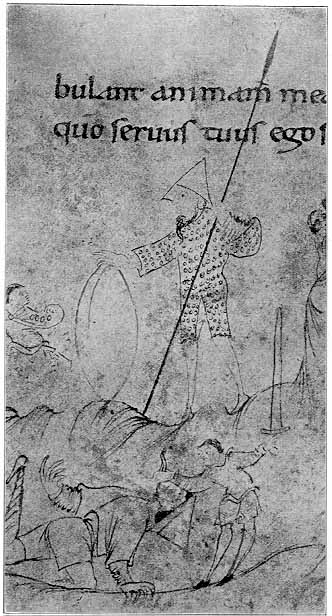 |
 |
|
VIIITH-XITH CENTURY Collection: Dr. Bashford Dean, New York |
He is armed with a spear, the head of which resembles Nos. 29 and 30. Harl. MS. 603, f 73. British Museum |
VIIITH-XITH CENTURY Found in the Thames, Kew. London Museum |
The two that we illustrate, one from the collection of Dr. Bashford Dean of New York (Fig. 29), and a simpler, but equally representative head of the same type, found in the Thames at London, now in the London Museum (Fig. 30), are representative. We are aware that this particular type of head with the lateral lugs at the half socket is assigned to a period anterior to that with which we now deal, but as an XIth century evidence of their continued use we reproduce from the Harl. MS. 603, f.73, the figure of Goliath armed with a spear, the head of which is apparently of this form (Fig. 31). It is interesting here to note that the oldest relic of the Romano-Germanic Empire, now preserved in the Imperial Treasury of Vienna, the lance-head known as that of St. Maurice, or the holy lance of Nuremberg, containing in the centre of its blade a nail of the Holy Cross, was originally just such a head as Dr. Dean's specimen.
As it now appears, the centre of the blade has been cut away to receive the relic. At some period in the reign of the Emperor Henry IV (1056-1106) the spear-head was broken in the centre and mended with bands of silver. On these bands are contemporary inscriptions recording the event. Further restorations and additions were added to the spear-head under the Emperor Charles IV (1347-1378). Our certain knowledge of this holy lance commences with the year A.D. 918, when Widukind, monk of the Abbey of Corbie, writes in that year it formed a part of the regalia of King Conrad I of Franconia (A.D 911-918). Its previous history is purely mythical.
|
Found in the Thames, Hammersmith. London Museum. |
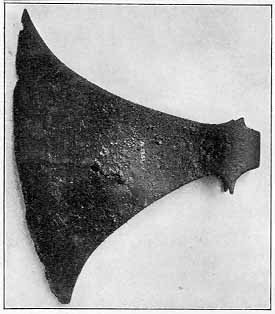 |
The axe, though used as it was by the knightly class of the old English, has seldom been found in any way enriched, though perhaps it was occasionally beautified in outline - indeed, of the many axe-heads discovered it is almost impossible to determine which are of English and which of Norman or Danish origin. The axe we may consider as Saxon is shown in our illustration (Fig. 32), a specimen found in the 'I'hames, whilst our illustration (Fig. 33) shows combatants, aimed with the axe matched against the spear.
|
Cott. MS. Cleop. C. viii, f. 24. British Museum |
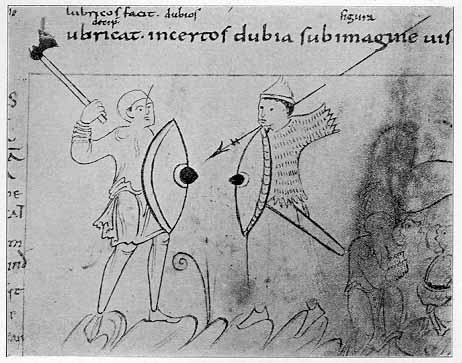 |
It must not be considered that the armaments which we have described as of old English origin were used in Britain alone; they represent the weapons of nearly all civilized Europe of the first quarter of the XIth century; we are likewise reluctantly forced to admit that the continental countries were ever in advance of Britain in the adaptation of new types, also that the continental workmanship shows a slight ascendancy over our insular production. As an example of this, finds made in Norway, Sweden, and Denmark show us workmanship of such a high quality and shapes so advanced that they might readily be considered to belong to a century later, but by circumstantial evidence they can be proved to be weapons offensive and defensive of the VIIIth, IXth, and Xth centuries.
 |
|
Found in the Thames at Wandsworth. London Museum |
The horses of the mounted soldiers or thegns were unprotected, and their trappings of the very simplest construction, though often rich and sumptuous in appearance. The bridles with which we are acquainted are merely of the ring snaffle type. An example fashioned of bronze found in the Thames at Wandsworth is now in the London Museum (Fig. 34). This specimen belongs to the earlier Saxon times.
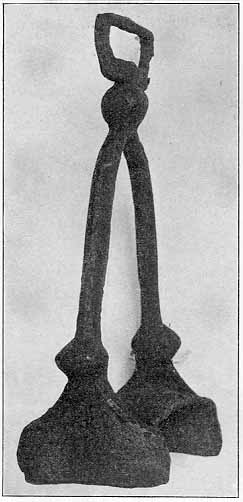 |
Found in Thames. London Museum |
|
Found in the Thames. London Museum |
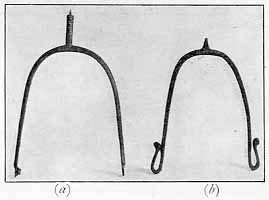 |
The formation of the stirrups, if not actually of leather thongs, was of the simplest triangular form, though in general outline they were little at variance with the shape in use to-day. A fine example now in the London Museum, decorated with brass inlay, was found in the Thames near the Tower of London (Fig. 35). The spurs of this period were of the prick order, the simple heel band and straight goad neck predominating (Fig. 36 a and b). We give illustrations of an elaborate pair of spurs that can safely be assigned to the first half of the XIth century (Fig. 37). They are remarkable examples of their kind, being highly enriched and in a wonderful state of preservation; indeed fragments of the leather attaching straps are still in existence. They are now in the possession of Mr. H. G. Radford. In all probability they are the spurs referred to in "The Book of the Ax " by George P. R. Pulman, on page 567, 1875 edition. Describing the church of St. Andrew, Chardstock, he goes on to say: "About thirty years ago, on removing part of the south aisle of the old church, a stone coffin was discovered in the midst of the outer wall. It contained parts of the skeleton, but the most interesting relics were the form of boots upon the bones of the feet and legs, with the spurs still undecayed. In all probability the remains were those of the founder of the aisle or the chief contributor to its erection."
 |
 |
|
First half of the XITH Century. Collection: H. G. Radford, Esq. |
We may consider these spurs are those referred to by Mr. Pulman, for they were re-discovered some four years ago in a small, but old, private collection not far from Lyme Regis, which is no great distance from Chardstock.
In the London Museum is a single spur of Saxon times, simple in construction, but enriched with scroll-work in brass and silver inlay. It was found in the Thames at Westminster (Fig. 38).
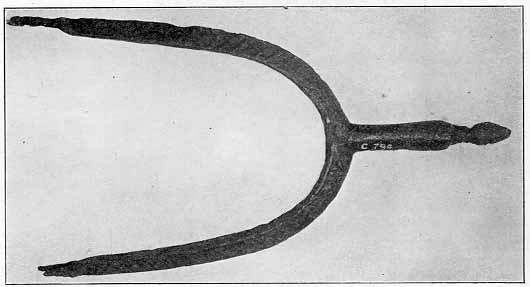 |
|
XTH or XITH century. Found in the Thames, Westminster. London Museum |
With this finishes our very rough account of the military accouterments of the first half of the IXth century, but so vague is the general idea of the armaments of the Anglo-Saxon, or, as we call him, the old Englishman, we can do no better than reproduce one of the cleverly reconstructed figures, the combined work of M. Viollet-le-Duc and Colonel le Clerc, preserved in the upper galleries of the Musée d'Artillerie of Paris, as a very fair illustration of how such warrior thegns would have appeared when in full fighting array. (Fig. 39).
 |
From the reconstructed model by M. Viollet-le-Duc and Colonel le Clerc in the Musée d' Artillerie of Paris. |
Chapter 2: Overview and
Armour


